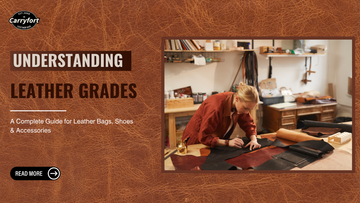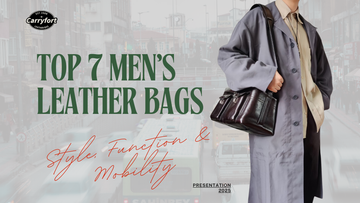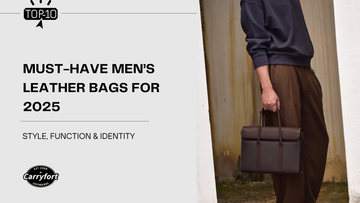Leather goods—whether it’s a premium leather backpack, a pair of classic leather boots, or a timeless leather duffel bag—are known for their durability, elegance, and enduring charm. However, not all leather is created equal. To make the right choice, it’s crucial to understand the different leather grades, animal hides, and how they’re used across various leather goods.
In this comprehensive guide, we’ll break down everything you need to know about leather—from the highest quality full-grain leather to faux leather imitations—and how to identify the best material for your needs.
🏆 1️⃣ Leather Grades: From Full-Grain to Faux Leather
Leather quality is often determined by its grade. Here’s what you need to know:
⭐ Full-Grain Leather
Full-grain leather is the highest quality leather available. It uses the top layer of the hide, retaining the natural grain and imperfections that give each piece character. Known for its durability and patina development, full-grain leather is the gold standard for premium leather bags, leather boots, and accessories.

⭐ Top-Grain Leather
Top-grain leather is slightly refined—its surface is sanded or buffed to remove blemishes. It’s more uniform in appearance and often used in high-quality leather laptop bags, messenger bags, and men’s leather shoes.

⭐ Genuine Leather
Despite its name, “genuine leather” is a lower grade. It’s made from the leftover layers of the hide, offering less durability and character compared to full-grain or top-grain leather.
⭐ Split Leather
This is the lower layer of the hide after the top has been removed. It’s less durable and often coated to mimic higher-grade leather. Common in budget-friendly leather bags and shoes.
⭐ Bonded Leather
Bonded leather is made from leather scraps bonded with polyurethane or latex. It’s the lowest quality real leather product and is best avoided if you want a product that lasts.

⭐ Faux Leather
Also known as synthetic or PU leather, faux leather is an artificial material made to look like leather. While it’s vegan and affordable, it lacks the breathability and aging characteristics of real leather.

💡 Important Note: Many cheap leather goods in the market use bonded or faux leather, misleading customers who think they’re getting genuine quality. Always double-check if your leather backpack or leather fanny pack is truly crafted from high-quality leather.
🐂 2️⃣ Common Animal Hides & Their Characteristics
Different animal hides offer unique features, making them ideal for specific leather goods:
✅ Cowhide
The most common leather for leather bags and leather boots. Durable, thick, and with a natural grain that develops character over time.

✅ Calfskin
Finer and smoother than cowhide, calfskin is prized for high-end leather shoes and luxury leather messenger bags. It’s soft, flexible, and ages beautifully.
✅ Buffalo Leather
Thicker and more robust than cowhide, buffalo leather is used in heavy-duty leather duffel bags and rugged men’s leather backpacks.

✅ Goatskin
Lightweight and supple, goatskin is often used in smaller accessories like wallets and leather waist bags. It’s soft and flexible.
✅ Sheepskin / Lambskin
Exceptionally soft and lightweight, sheepskin and lambskin are popular in fashion-forward leather goods and apparel.
✅ Exotic Leathers
Leathers from crocodile, ostrich, and snake are luxury materials with unique textures. They’re used in designer bum bags, wallets, and statement pieces.
🎒 3️⃣ Leather in Bags, Shoes & Other Accessories
Understanding how different leathers are used helps you choose the right product:
👜 Leather Bags
-
Leather Backpacks: Durable and stylish, perfect for daily use or travel.

-
Leather Laptop Bags & Messenger Bags: Professional and long-lasting.
-
Leather Duffel Bags & Travel Bags: Ideal for short trips or gym bags.

-
Waist Bags & Bum Bags: Compact and convenient for on-the-go storage.
👞 Leather Shoes & Boots
-
Leather Boots: From rugged work boots to sleek Chelsea boots.

-
Leather Dress Shoes: Timeless pieces for any formal wardrobe.

-
Leather Sneakers: Combining comfort with luxury.
🧤 Accessories & More
-
Belts, Gloves & Wallets: Everyday essentials that showcase leather’s versatility.

-
Specialty Goods: Horse saddles, motorcycle gear, and protective holsters.
🔍 4️⃣ How to Identify Real Leather vs. Faux Leather
With so many leather goods on the market, here’s how to tell the difference:

✅ Look at the Texture: Real leather has natural grain variations. Faux leather often has a perfect, uniform pattern.
✅ Smell Test: Real leather has a distinct earthy smell, while faux leather smells like plastic.
✅ Feel: Real leather feels supple and warm to the touch; faux leather feels cold and plastic-like.
✅ Water Test: A small drop of water absorbs into real leather, while it beads on faux leather.
⚠️ Beware of Cheap Imitations: Some manufacturers use split leather or faux leather to cut costs, especially in lower-end leather bags and accessories. Investing in full-grain or top-grain leather ensures you’re getting a product that will last.
🛠️ 5️⃣ Care Tips for Leather Goods
Proper care keeps your leather backpacks and leather shoes looking their best:

-
Clean regularly with a damp cloth or a specialized leather cleaner.
-
Condition with leather balm to prevent drying and cracking.
-
Store in a cool, dry place away from direct sunlight.
-
Avoid overloading your leather bag to maintain its shape.
💡 6️⃣ Final Thoughts: Choosing the Right Leather for Your Needs
When it comes to choosing leather, your budget and intended use matter:
👉 If you want timeless durability for your men’s leather briefcase or leather duffel bag, full-grain or top-grain leather is the way to go.
👉 For those looking for affordability or vegan options, faux leather might be a suitable choice, but don’t expect it to age as gracefully.
👉 Always read product descriptions carefully and double-check leather grades when buying online.
At Carryfort, we’re committed to using only the finest materials in our leather bags, leather shoes, and accessories. Explore our collection today and discover the perfect balance of craftsmanship and style.





